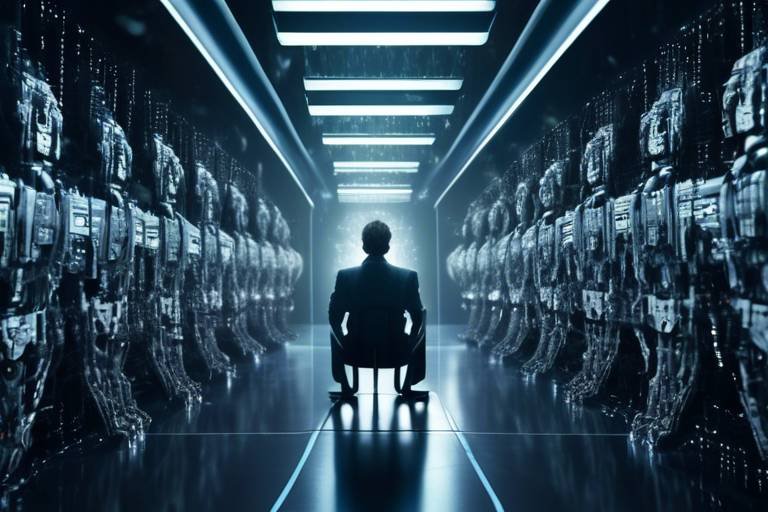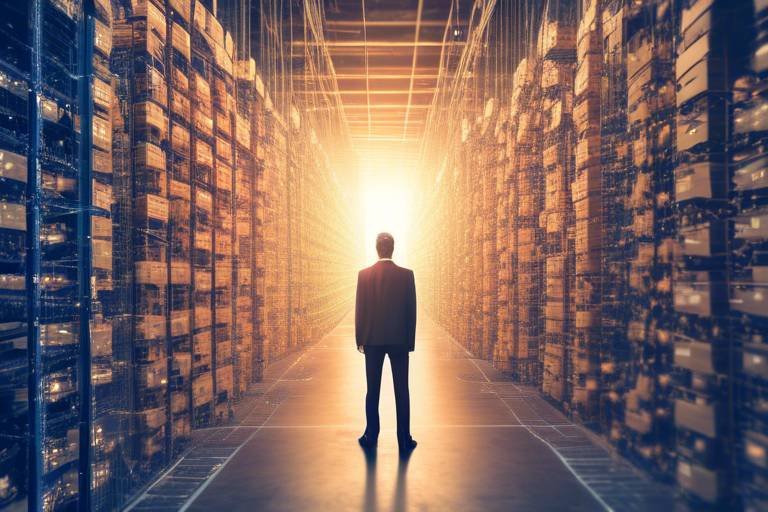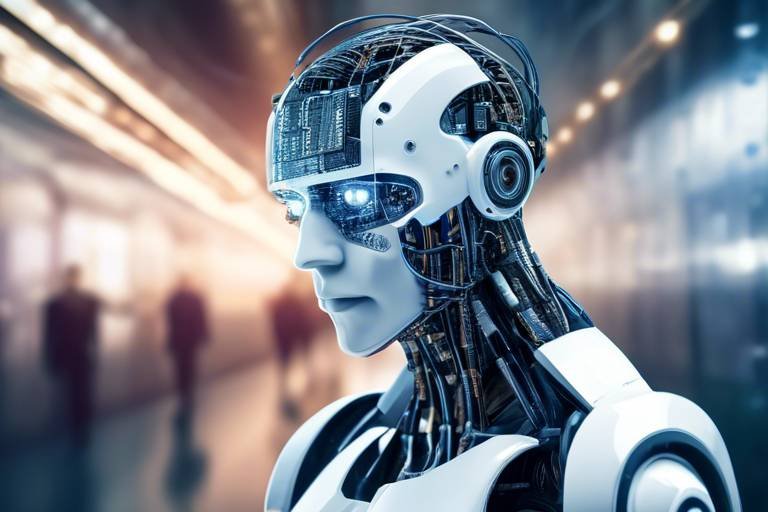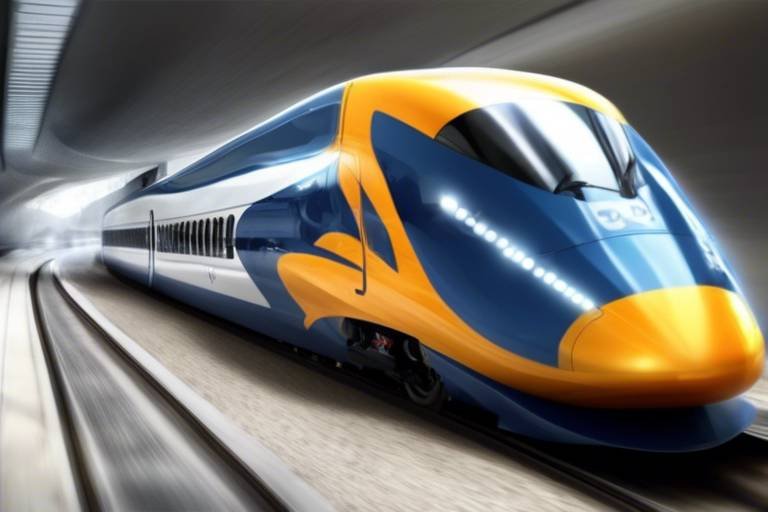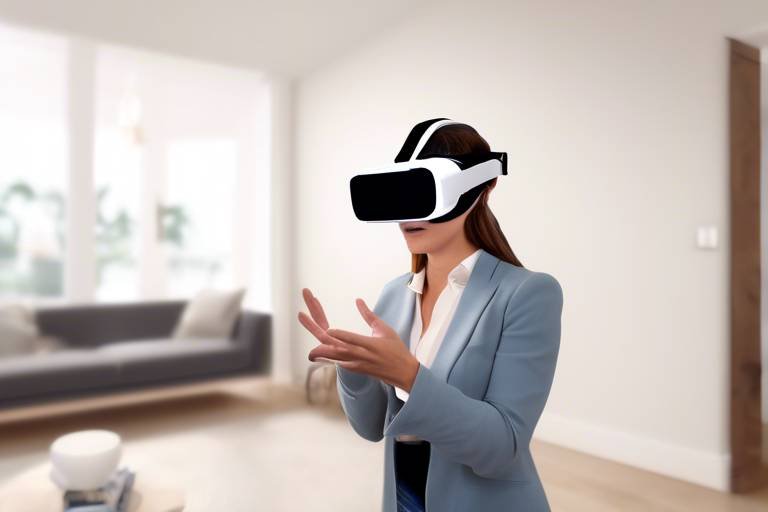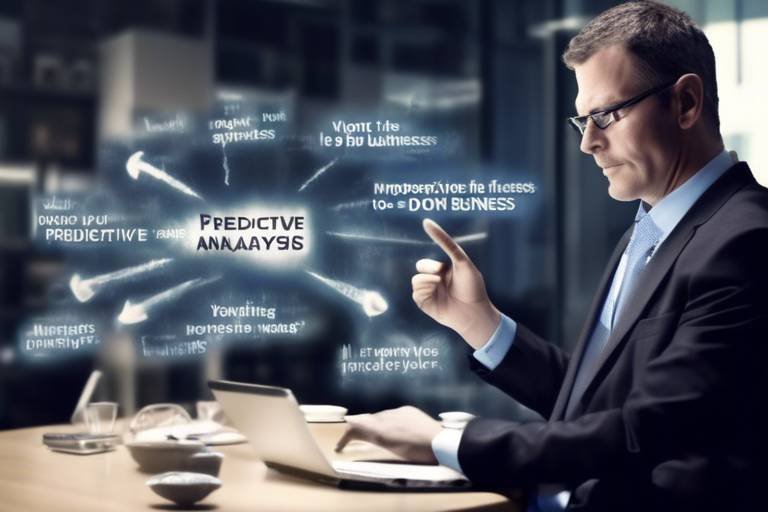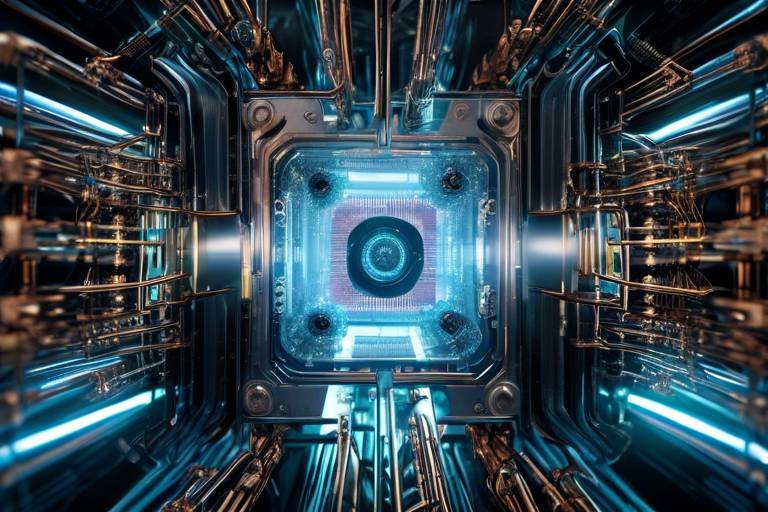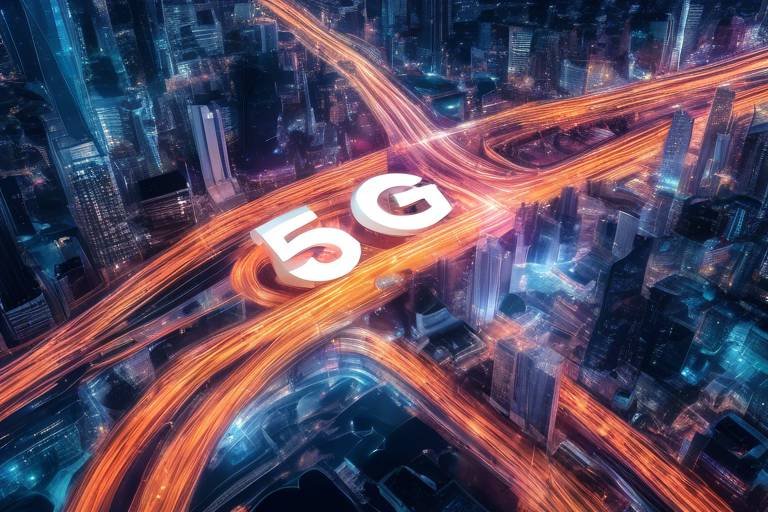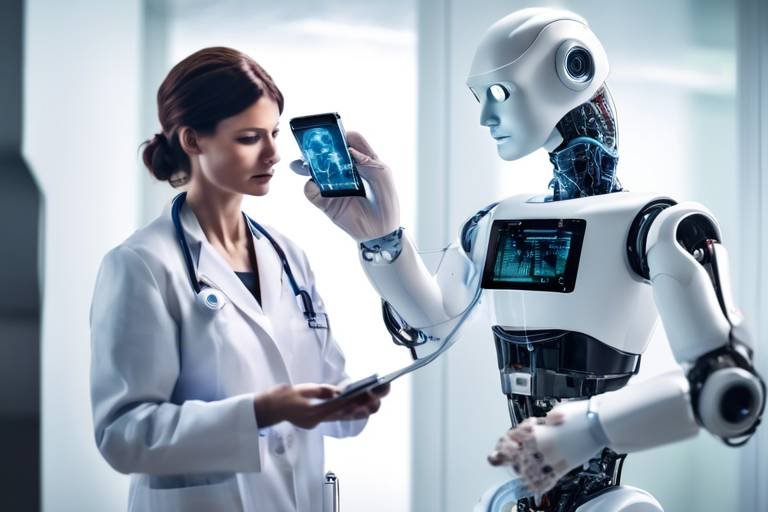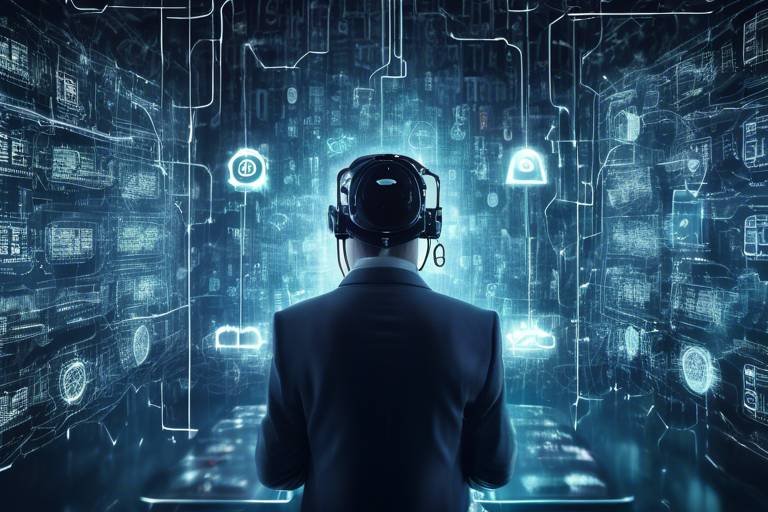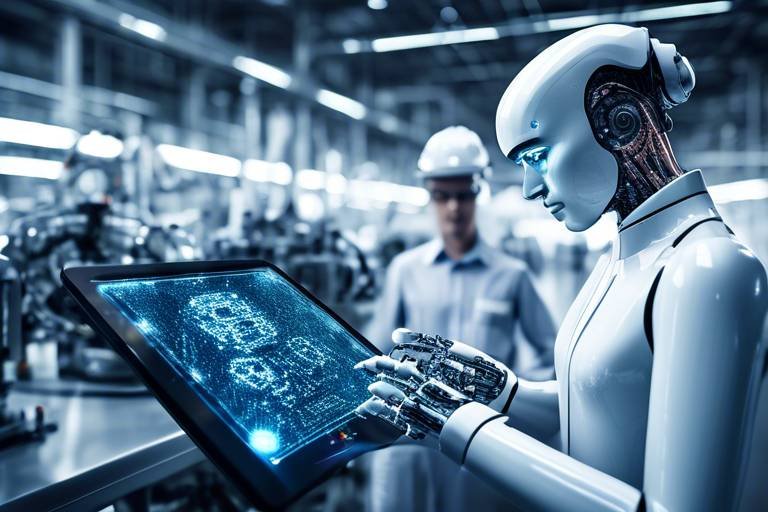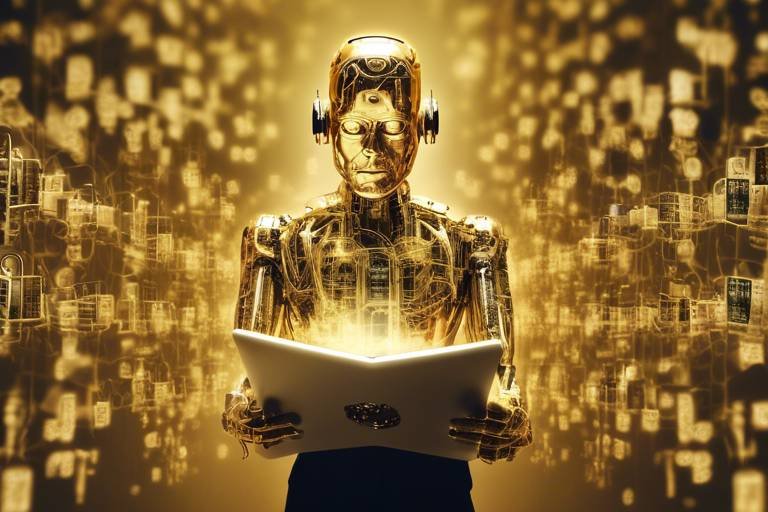Artificial Intelligence: Transforming the Film Industry
The film industry has always been a realm of creativity and innovation, but in recent years, it has witnessed a revolutionary shift with the advent of artificial intelligence (AI). This technology is not just a passing trend; it is fundamentally altering how films are made, marketed, and experienced. Imagine a world where scripts are crafted with the help of algorithms, where editing is faster and more precise, and where marketing strategies are tailored to individual preferences. This is the new reality of cinema, and it is exciting to see how AI is paving the way for a more efficient and engaging film experience.
One of the most fascinating aspects of AI's impact on the film industry is its ability to analyze vast amounts of data to identify trends and preferences. This capability allows filmmakers to create stories that resonate with audiences on a deeper level. Whether it's through enhancing scriptwriting or optimizing production processes, AI is becoming an indispensable tool for filmmakers. The integration of AI into various stages of filmmaking is not just about efficiency; it also opens the door to new creative possibilities that were previously unimaginable.
As we delve deeper into the various applications of AI in the film industry, it becomes clear that this technology is not just enhancing existing processes but is also redefining the future of cinema. From the initial stages of script development to the final touches in post-production and even the marketing strategies employed to reach audiences, AI is making its mark. In the following sections, we will explore how AI is transforming scriptwriting, production, and audience engagement, highlighting both the opportunities and challenges that come with this technological revolution.
In the realm of storytelling, AI is proving to be a valuable partner for writers. By analyzing successful narratives and audience preferences, AI tools can help generate unique story ideas and assist in crafting compelling scripts. This collaboration between human creativity and machine intelligence is paving the way for a new era of storytelling that can captivate audiences in unprecedented ways. As we continue our exploration, we will see how these advancements are not only enhancing the filmmaking process but also enriching the viewer's experience.
- How is AI used in scriptwriting? AI analyzes trends and generates ideas, helping writers create compelling narratives.
- What are the benefits of AI in film production? AI streamlines processes, saving time and resources, and improves efficiency.
- Can AI replace human editors? While AI assists in editing, it cannot fully replace the artistic intuition of human editors.
- How does AI impact film marketing? AI analyzes audience data to create targeted advertising campaigns, enhancing film visibility.
- What is predictive analytics in the film industry? It uses AI to forecast box office success based on historical data, aiding decision-making.

The Role of AI in Scriptwriting
Artificial Intelligence is not just a buzzword; it's a game-changer in the world of scriptwriting! Imagine having a virtual assistant that can analyze trends, understand audience preferences, and even generate story ideas tailored to specific genres. Sounds like something out of a sci-fi movie, right? But it's happening now, and it's transforming how writers approach their craft. In this new era, AI tools are stepping in to assist writers, enhancing their creativity and helping them craft compelling narratives.
One of the most fascinating aspects of AI in scriptwriting is its ability to analyze vast amounts of data. By examining successful films, AI can identify patterns in storytelling, character development, and dialogue. This data-driven approach allows writers to create scripts that resonate with audiences. For instance, if a particular plot twist has proven successful in the past, AI can suggest incorporating similar elements into new scripts, providing writers with a solid foundation to build upon.
Moreover, AI doesn't just stop at analysis; it actively participates in the creative process. Some advanced AI systems can generate story ideas based on specific parameters set by the writer. For example, if a writer is interested in a romantic comedy set in a futuristic world, AI can propose unique plotlines or character arcs that the writer might not have considered. This collaboration between human creativity and machine intelligence is paving the way for more innovative storytelling.
However, while AI can provide valuable insights and suggestions, it's essential to remember that the heart of storytelling lies within human emotion and experience. AI may excel at data analysis, but it lacks the personal touch that makes stories relatable. Writers are the ones who infuse scripts with emotions, cultural nuances, and unique perspectives. Therefore, the most effective approach is for writers to use AI as a tool rather than a replacement. By leveraging AI's capabilities, writers can enhance their creativity while retaining their distinctive voice.
To illustrate the impact of AI in scriptwriting, consider the following table showcasing some AI tools currently being used in the industry:
| AI Tool | Functionality |
|---|---|
| ScriptBook | Analyzes scripts to predict box office success and audience reception. |
| Final Draft | Offers AI-driven suggestions for dialogue and character development. |
| Plotagon | Generates animated stories based on user-defined parameters. |
As we look to the future, the role of AI in scriptwriting will undoubtedly continue to evolve. Writers who embrace these technologies will find themselves equipped with powerful tools that enhance their creativity and storytelling capabilities. The synergy between human creativity and AI's analytical prowess can lead to groundbreaking narratives that captivate audiences worldwide. So, the next time you watch a film, remember that behind the scenes, AI might just have played a role in crafting that compelling story!

AI in Film Production
Artificial Intelligence is not just a buzzword; it's becoming an essential player in the film production landscape. Imagine a world where the tedious tasks of pre-production, shooting, and post-production are streamlined through the power of AI. This is not science fiction—it's happening right now! AI tools are revolutionizing the way filmmakers approach their craft, making processes faster, more efficient, and often more creative.
One of the most significant areas where AI is making a mark is in pre-production planning. Traditionally, this phase involves countless hours of brainstorming, scheduling, and budgeting. But with AI, filmmakers can analyze scripts and project requirements quickly. For instance, AI algorithms can evaluate the feasibility of a script based on budget constraints and available resources. This means that filmmakers can focus more on their creative vision rather than getting bogged down by logistical headaches.
During the actual filming, AI technologies can assist in various ways. From managing schedules to optimizing shot lists, AI can analyze data in real-time to ensure that everything runs smoothly on set. Imagine having a virtual assistant that can predict potential delays based on weather forecasts or actor availability. This kind of foresight can save filmmakers not just time but also significant amounts of money!
Now, let's talk about the magic that happens in post-production. Automated editing software is a game-changer in this realm. By leveraging AI, these tools can analyze hours of footage and suggest edits that align with the director's vision. This isn't just about cutting down hours of work; it's about enhancing the creative process. Editors can experiment with different cuts and styles, allowing for a more fluid and dynamic editing experience.
So, what are the tangible benefits of using AI in editing? Here are a few:
- Faster Turnaround Times: AI can drastically reduce the time it takes to produce a final cut, allowing for quicker releases and more projects to be tackled.
- Creative Options: With AI suggesting edits, editors can explore new creative avenues they might not have considered otherwise.
- Consistency: AI tools can maintain a level of consistency across different scenes, ensuring that the final product feels cohesive.
However, it's essential to acknowledge that AI editing tools aren't without their challenges. One of the most significant concerns is maintaining artistic integrity. Can a machine truly understand the emotional nuances that a human editor feels? While AI can analyze patterns and trends, it may struggle with the subtleties of storytelling that require a human touch. There's also the concern of over-reliance on technology, which could lead to a homogenization of film styles.
In conclusion, AI is undeniably transforming film production, from planning to editing. While it presents exciting opportunities, it also raises questions about the future of creativity in cinema. As filmmakers embrace these technologies, the challenge will be to strike a balance between innovation and the unique human elements that make storytelling so powerful.

Automated Editing Software
In the fast-paced world of filmmaking, time is of the essence. With the increasing amount of footage captured during shoots, editors often find themselves sifting through hours of material to piece together a coherent narrative. This is where comes into play, leveraging the power of artificial intelligence to transform the editing landscape. By analyzing footage, these advanced tools can suggest cuts, transitions, and even the overall structure of a film, allowing editors to focus more on the creative aspects of their work.
Imagine having a personal assistant that never tires, tirelessly reviewing every frame and identifying the most compelling moments. Automated editing software does just that, using sophisticated algorithms to recognize patterns, themes, and emotional beats in the footage. This not only speeds up the editing process but also enhances the editor's creative decision-making. It's like having an extra set of eyes that can quickly pinpoint the best shots while still leaving room for the editor's unique vision.
One of the remarkable features of these AI-driven tools is their ability to learn and adapt over time. As they analyze more projects, they become better at understanding the nuances of storytelling and pacing. For instance, if an editor consistently opts for a certain type of transition or prefers specific music cues, the software can start to recommend similar choices, tailoring its suggestions to the individual’s style. This personalization is a game-changer, allowing filmmakers to maintain their artistic integrity while benefiting from the efficiency that AI provides.
However, while the advantages of automated editing software are significant, it's crucial to acknowledge some of the challenges that come with it. The reliance on algorithms can sometimes lead to a disconnect between the technology and the emotional depth of storytelling. AI may excel at identifying technical aspects of a scene, but it can struggle with the subtleties of human emotion that make a film truly resonate with its audience. Thus, the role of the editor remains vital; they must blend their artistic intuition with the insights provided by these tools.
In summary, automated editing software represents a revolutionary leap in the film editing process. By combining the analytical prowess of AI with the creative instincts of human editors, the filmmaking industry is poised for greater efficiency and innovation. As these technologies continue to evolve, we can only imagine the incredible stories that will emerge from this dynamic collaboration.

Benefits of AI Editing Tools
Artificial intelligence is not just a buzzword; it’s a game changer in the film editing landscape. The are numerous and incredibly impactful. First off, these tools significantly accelerate the editing process. Imagine a world where hours of manual labor are reduced to mere minutes! AI can analyze footage faster than any human editor, suggesting cuts and transitions that might take a traditional editor much longer to identify.
Moreover, AI editing tools enhance creative decision-making. They can provide recommendations based on trends and viewer preferences, allowing editors to experiment with different styles and techniques without the usual time constraints. This not only saves time but also opens up a realm of possibilities for creativity. For instance, AI can analyze thousands of films to suggest the most effective pacing or emotional beats that resonate with audiences.
Another significant advantage is the cost-effectiveness. By streamlining the editing process, filmmakers can allocate their budgets more efficiently. This is especially crucial for independent filmmakers who often work with limited resources. With AI, they can achieve high-quality results that might otherwise be out of reach.
Furthermore, AI tools often come with built-in features that can detect and correct technical issues, such as color grading or sound balancing. This means that editors can focus more on the artistic aspects of their work rather than getting bogged down by technicalities. For example, an AI tool might automatically adjust the color tones of a scene to match the desired mood, saving valuable time and ensuring visual consistency throughout the film.
However, while the advantages are clear, it’s essential to remember that AI editing tools are designed to assist, not replace human creativity. The collaboration between human editors and AI can lead to masterpieces that blend technical precision with artistic vision. To illustrate, here’s a quick look at some of the key benefits:
| Benefit | Description |
|---|---|
| Speed | Reduces editing time significantly by automating repetitive tasks. |
| Creativity | Offers suggestions based on analysis of successful films, enhancing creative choices. |
| Cost-Effectiveness | Helps filmmakers stay within budget by streamlining workflows. |
| Technical Assistance | Automatically corrects technical issues, allowing focus on artistic elements. |
In conclusion, the integration of AI editing tools into the filmmaking process is proving to be a revolutionary step forward. By harnessing the power of technology, filmmakers can not only enhance their productivity but also push the boundaries of creativity. As we continue to explore the evolving relationship between AI and film, it’s clear that the future of editing is bright and full of potential.
- How does AI improve the editing process? AI improves editing by automating repetitive tasks, suggesting cuts, and providing creative insights based on data analysis.
- Can AI tools replace human editors? While AI tools can assist and enhance the editing process, they are designed to work alongside human editors, not replace them.
- What types of films benefit most from AI editing tools? Both independent and big-budget films can benefit, especially when time and resources are limited.
- Are AI editing tools cost-effective? Yes, they can save costs by reducing editing time and streamlining workflows, making them accessible for filmmakers on a budget.

Challenges in AI Editing
While the integration of AI in film editing has brought about significant advancements, it is essential to recognize the challenges that accompany this technological shift. One of the primary concerns is the preservation of artistic integrity. Filmmakers often worry that AI tools, while efficient, might lack the human touch that makes a film resonate emotionally with audiences. After all, editing is not just about cutting and rearranging clips; it is an art form that requires a deep understanding of the narrative and emotional nuances.
Moreover, AI editing software relies heavily on algorithms that analyze footage to suggest edits. This process, while expedient, can sometimes overlook the subtleties of storytelling. For example, an AI might suggest a cut that enhances pacing but fails to capture a character's emotional journey. The challenge lies in finding a balance between efficiency and emotional depth, ensuring that the final product reflects the filmmaker's vision.
Another challenge is the learning curve associated with adopting AI tools. Many filmmakers, especially those accustomed to traditional editing methods, may find it daunting to incorporate AI into their workflow. This can lead to resistance against new technologies, as some may feel that relying on AI diminishes their creative control. To address this, training and education are crucial. Filmmakers need to understand how to leverage AI tools effectively without compromising their artistic vision.
Additionally, there are concerns about the understanding of context and cultural sensitivity by AI systems. Algorithms are trained on existing data, and if that data lacks diversity or is biased, it can lead to problematic editing choices that may inadvertently perpetuate stereotypes or overlook important cultural contexts. This highlights the importance of human oversight in the editing process, ensuring that the final cut is not only technically sound but also socially responsible.
In summary, while AI editing tools offer remarkable benefits, filmmakers must navigate the challenges of maintaining artistic integrity, understanding context, and managing the learning curve associated with new technologies. As the film industry continues to evolve, it will be vital for creators to find ways to integrate AI while preserving the heart and soul of their stories.
- What are the main benefits of using AI in film editing? AI can significantly speed up the editing process, provide creative suggestions, and enhance overall efficiency.
- Can AI fully replace human editors? While AI can assist in the editing process, it cannot replace the emotional understanding and creative intuition of human editors.
- How can filmmakers ensure AI tools respect artistic integrity? Filmmakers should maintain oversight and use AI as a supplementary tool rather than a replacement for human creativity.
- What are some examples of AI tools used in film editing? Tools like Adobe Premiere Pro's Sensei and Avid's Media Composer provide AI-driven features that assist in editing.

Visual Effects and AI
In the world of filmmaking, visual effects (VFX) have become a cornerstone of modern cinema, allowing filmmakers to create breathtaking worlds and jaw-dropping sequences that captivate audiences. With the advent of artificial intelligence, the landscape of visual effects is undergoing a remarkable transformation. Imagine a world where the boundaries of imagination are pushed, where the impossible becomes possible, all thanks to the power of AI. This technology is not just a tool; it’s a creative partner that enhances the storytelling experience by enabling filmmakers to craft stunning visuals that resonate with viewers on a deeper level.
AI algorithms are now capable of analyzing vast amounts of data, learning from previous films, and even understanding the intricacies of human emotions. This capability allows AI to assist in the creation of realistic simulations and enhanced CGI. For instance, by leveraging machine learning, filmmakers can generate lifelike characters or environments that would be incredibly time-consuming to create manually. The efficiency gained from AI-driven tools means that artists can focus more on their creative vision rather than getting bogged down by technical limitations.
One fascinating application of AI in visual effects is in the realm of motion capture. Traditionally, capturing the nuanced movements of actors required extensive setup and post-processing. However, with AI, the data from motion capture can be processed in real-time, allowing filmmakers to see the effects as they shoot. This not only speeds up the production process but also opens up new avenues for creativity, as directors can experiment with different effects on the fly.
Moreover, AI is revolutionizing the way visual effects are integrated into live-action footage. By utilizing advanced algorithms, filmmakers can seamlessly blend CGI with real-world elements, creating a more immersive experience. This technology enables the creation of dynamic environments and complex interactions between characters and their surroundings, making the impossible seem effortless.
However, while the advantages of AI in visual effects are significant, there are also challenges that come with it. Maintaining the artistic integrity of a film while relying on algorithms can be tricky. Filmmakers must ensure that the human touch is not lost amidst the technological advancements. Additionally, understanding the emotional nuances that make a scene resonate with audiences can sometimes elude AI, which may lead to a disconnect between the visuals and the story being told.
In summary, the integration of AI in visual effects is not just about enhancing visuals; it’s about redefining storytelling. As filmmakers continue to explore the capabilities of AI, we can expect to see a new era of cinema where imagination knows no bounds. The collaboration between human creativity and artificial intelligence is paving the way for a future where every frame can be a masterpiece.
- How is AI used in visual effects?
AI is used to analyze data, create realistic simulations, and enhance CGI, allowing filmmakers to produce stunning visuals efficiently. - What are the benefits of using AI in filmmaking?
AI streamlines production processes, reduces costs, and allows for more creative freedom, enabling filmmakers to focus on storytelling. - Are there any challenges with AI in visual effects?
Yes, maintaining artistic integrity and understanding emotional nuances can be challenging when relying on AI technology.

AI in Marketing and Distribution
Artificial intelligence is not just a buzzword; it’s a game-changer in the film industry, especially when it comes to marketing and distribution. Imagine a world where every film’s promotional strategy is tailored specifically to the audience most likely to watch it. That’s the power of AI! By analyzing vast amounts of data, AI helps filmmakers and marketers understand viewer preferences, habits, and trends better than ever before. This means that the days of generic advertisements are fading away, making room for more personalized and engaging campaigns.
One of the most fascinating aspects of AI in marketing is its ability to create targeted advertising. Using algorithms, AI can sift through viewer data to identify patterns and predict which demographics will resonate with a particular film. This allows studios to focus their marketing efforts where they matter most, ensuring that every dollar spent on advertising has a higher chance of converting into ticket sales. For instance, if a film features a strong female lead, AI can identify and target female audiences who have shown interest in similar genres or themes, maximizing engagement.
Moreover, AI tools can optimize social media campaigns in real-time. By monitoring engagement metrics, AI can suggest adjustments to content, timing, and even the platforms used for promotion. This dynamic approach not only enhances visibility but also ensures that the marketing strategy evolves with audience reactions. Can you imagine the thrill of seeing your film’s trailer go viral because AI pinpointed the perfect moment to share it?
Another crucial area where AI shines is in predictive analytics. Studios can leverage AI to analyze historical box office data, audience demographics, and even social media sentiment to forecast a film’s potential success. This data-driven approach allows filmmakers to make informed decisions about production budgets, release dates, and marketing strategies. For example, if a similar film performed exceptionally well during a particular season, AI can suggest a strategic release window for the new film to capitalize on that momentum.
| AI Application | Description |
|---|---|
| Targeted Advertising | Creating personalized ad campaigns based on viewer preferences and historical data. |
| Social Media Optimization | Real-time adjustments to marketing strategies based on audience engagement metrics. |
| Predictive Analytics | Forecasting box office performance using historical data and audience insights. |
However, while the benefits of AI in marketing and distribution are clear, there are also challenges to consider. For instance, relying too heavily on algorithms can sometimes overlook the human element of storytelling and audience connection. It’s crucial for filmmakers to balance data-driven decisions with the emotional and artistic aspects of their work. After all, films are not just products; they are stories that resonate with people on a personal level.
In conclusion, AI is revolutionizing the way films are marketed and distributed. By harnessing the power of data, filmmakers can create more effective marketing strategies, engage audiences more deeply, and ultimately drive better box office results. As we continue to see advancements in AI technology, it’s exciting to think about how it will further shape the future of cinema.
- How does AI improve targeted advertising for films?
AI analyzes viewer data to identify patterns and preferences, allowing studios to create personalized ad campaigns that resonate with specific demographics.
- Can AI predict a film's box office success?
Yes, AI uses historical data and audience insights to forecast potential box office performance, helping studios make informed decisions about marketing and distribution.
- What are the challenges of using AI in film marketing?
While AI offers many benefits, it can sometimes overlook the emotional connection that audiences have with films, making it essential to balance data-driven strategies with human storytelling.

Targeted Advertising
In the digital age, where attention spans are shorter than ever, is emerging as a game changer for the film industry. Imagine walking into a theater and seeing a trailer that feels like it was made just for you. That's the magic of AI-driven advertising! By analyzing vast amounts of data from social media interactions, viewing habits, and even search histories, AI algorithms can identify specific audience segments that are most likely to resonate with a particular film. This means that instead of casting a wide net and hoping for the best, filmmakers can now tailor their marketing efforts to reach the right people at the right time.
For instance, if a film features a strong female lead and is packed with action, AI can sift through data to find audiences that have shown interest in similar genres or themes. The result? A marketing campaign that feels personal and engaging. Not only does this approach increase the likelihood of ticket sales, but it also fosters a deeper connection between the audience and the film. Think of it as a customized playlist; just as you’re more likely to enjoy songs tailored to your tastes, viewers are more inclined to watch films that speak directly to their interests.
Moreover, the effectiveness of targeted advertising can be measured in real-time, allowing studios to tweak their campaigns on the fly. If an ad isn't performing well, adjustments can be made almost instantly based on viewer engagement metrics. This agility is crucial in a fast-paced environment where trends can change overnight. By leveraging AI, filmmakers can stay ahead of the curve, ensuring their films remain relevant and visible in a crowded marketplace.
Here’s a quick breakdown of how targeted advertising works in the film industry:
| Step | Description |
|---|---|
| Data Collection | AI gathers data from various sources, including social media, streaming services, and search engines. |
| Audience Segmentation | Algorithms analyze the data to identify distinct audience segments based on interests and behaviors. |
| Ad Creation | Customized ads are generated to appeal to the identified segments, ensuring relevance. |
| Real-Time Analysis | Campaign performance is monitored, allowing for immediate adjustments to improve engagement. |
As we move forward, the role of targeted advertising in the film industry will only continue to grow. It's not just about selling tickets; it's about creating an experience that resonates with viewers on a personal level. So, the next time you see a trailer that feels like it was made just for you, remember: that’s AI at work, crafting a cinematic journey tailored to your tastes!
- What is targeted advertising? Targeted advertising refers to the practice of delivering personalized ads to specific audience segments based on their interests and behaviors.
- How does AI improve targeted advertising? AI analyzes large datasets to identify audience preferences, allowing for more relevant and engaging advertising campaigns.
- Can targeted advertising really increase ticket sales? Yes, by reaching the right audience with tailored messages, targeted advertising can significantly boost engagement and ticket sales.
- What data is used for targeted advertising? Data from social media, streaming services, and online searches is commonly used to inform targeted advertising strategies.

Predictive Analytics in Box Office Performance
Predictive analytics is rapidly becoming a game-changer in the film industry, especially when it comes to understanding and forecasting box office performance. By utilizing sophisticated algorithms and analyzing vast amounts of historical data, studios can now make informed predictions about how a film will perform once it's released. This approach not only enhances decision-making but also minimizes financial risks associated with film production.
At its core, predictive analytics leverages data from various sources, including:
- Previous box office performances of similar genres
- Viewer demographics and preferences
- Marketing campaign effectiveness
- Social media buzz and engagement metrics
By analyzing these factors, studios can forecast not just the potential earnings of a film, but also identify the optimal release dates and marketing strategies. For instance, if a studio is planning a romantic comedy, they might look at trends from past romantic comedies released during Valentine's Day. This historical insight can provide a clearer picture of expected audience turnout and revenue.
Moreover, predictive analytics can be used to evaluate the impact of star power and director reputation on a film's success. By assessing how films with similar cast members or directors have performed in the past, studios can gauge whether investing in a particular actor or director is likely to yield a profitable return. This data-driven approach helps in making strategic choices that align with audience expectations.
To illustrate the effectiveness of predictive analytics, consider the following table that showcases how different factors contribute to box office predictions:
| Factor | Impact on Prediction |
|---|---|
| Genre | Identifies audience preferences and past performance trends. |
| Cast | Influences audience interest and potential draw. |
| Marketing Spend | Affects visibility and audience engagement levels. |
| Release Timing | Aligns with audience availability and competition. |
As the film industry continues to evolve, the integration of predictive analytics will likely become even more sophisticated. The ability to forecast box office performance accurately not only aids in financial planning but also enhances the overall strategy for film releases. Ultimately, studios that embrace these advanced analytics tools will have a competitive edge, allowing them to make smarter decisions that resonate with audiences.
In conclusion, predictive analytics is revolutionizing how studios approach film production and marketing. By harnessing the power of data, they can navigate the complex landscape of audience preferences and market dynamics, ensuring that every film has the best chance of success at the box office.
- What is predictive analytics in the film industry? Predictive analytics involves using historical data and algorithms to forecast a film's box office performance and audience engagement.
- How does predictive analytics help film studios? It helps studios make informed decisions about production, marketing strategies, and release timing, reducing financial risks.
- What types of data are analyzed for predictive analytics? Studios analyze data from past performances, viewer demographics, marketing effectiveness, and social media engagement.
- Can predictive analytics guarantee a film's success? While it enhances forecasting accuracy, it cannot guarantee success due to the unpredictable nature of audience preferences.
Frequently Asked Questions
- How is AI changing scriptwriting in the film industry?
AI is transforming scriptwriting by analyzing trends and generating unique story ideas. Writers can now leverage algorithms to explore various narrative possibilities, enhancing creativity and helping them craft compelling scripts that resonate with audiences.
- What are the benefits of using AI in film production?
AI streamlines numerous filmmaking processes, from pre-production planning to post-production editing. By automating routine tasks, filmmakers save valuable time and resources, allowing them to focus more on the creative aspects of filmmaking.
- How does automated editing software work?
Automated editing software utilizes AI to analyze raw footage and suggest edits based on patterns and trends. This technology not only speeds up the editing process but also provides editors with creative options they might not have considered.
- What challenges do AI editing tools face?
Despite their advantages, AI editing tools can struggle with maintaining artistic integrity and understanding emotional nuances in scenes. Filmmakers must balance the efficiency of AI with the need for human touch in storytelling.
- How is AI used in creating visual effects?
AI enhances visual effects by enabling filmmakers to create realistic simulations and improve CGI quality. This technology allows for more immersive experiences, captivating audiences with stunning visuals that were once difficult to achieve.
- What role does AI play in film marketing?
AI is crucial in film marketing as it analyzes audience data to create targeted advertising campaigns. By understanding viewer preferences, studios can enhance film visibility and improve box office performance through data-driven strategies.
- How does predictive analytics help in box office forecasting?
Predictive analytics powered by AI allows studios to forecast box office success by analyzing historical data and trends. This technology aids in making informed decisions regarding production and distribution, increasing the chances of a film's success.

